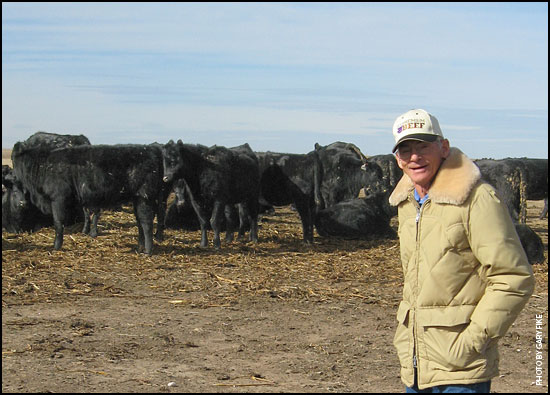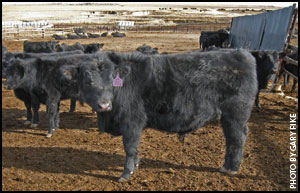
Quality Lessons
A life’s study culminates in this Kansas cow herd.
Leonard Tucker has spent most of his life as a student of the cattle industry — both in and out of the classroom.
His first lessons came from Roscoe Coberly’s Gove County, Kan., ranch and feedlot, where his parents worked. Experience grew to include haying for a Nebraska producer during the summers and owning a few steers throughout his childhood and teenage years.
“I remember my first calf went to Witherspoon Commission Co. in Kansas City, back when I was in the third grade,” says Tucker, whose slender build and weathered features provide evidence of a life filled with hard work. He now owns more than 450 cows with his wife, Judy, near their western Kansas hometown. Sons Whitney and Lincoln share the workload, but also have herds of their own. Youngest son Jesse, now based in Wichita, Kan., spent time on the operation before earning his law degree.
Although Tucker has always been in the cattle business, he didn’t start his cow herd until he purchased three loads of bred heifers 12 years ago.
He didn’t take a 25-year hiatus from the industry, though. The gap between high school and becoming a cow-calf producer was filled with other learning opportunities. Tucker earned a degree in animal science from Kansas State University (K-State) in 1970 and then worked toward a master’s degree before returning to Gove in 1972. He managed Coberly’s feedyard for 16 years, spent time as an order buyer and managed stocker cattle on land he purchased in the 1980s.
“I knew what kind of carcass I wanted to generate,” Tucker says. “When I decided to go into the cow business then, we made our own cows” to fit that model.
Those initial female purchases were made only after checking out their bloodlines with seedstock supplier Dick Janssen, Green Garden Angus Farm, of Ellsworth, Kan.
“He told me they would make a great base of females,” Tucker says. Those heifers made up the beginnings of the spring herd, which now numbers 380 head, while Angus-based heifers from Nebraska jump-started the 110-head fall-calving herd.
From there, he kept replacements and began retaining partial ownership of feeder calves. The source- and age-verified animals go to a preconditioning yard and on a sorghum silage ration before moving on to one of the local finishing yards.
 Ranger Feeders, a Certified Angus Beef LLC (CAB)-licensee near Dighton, Kan., fed 73 Tucker steers last year that went 96% Choice, with 58% qualifying for Certified Angus Beef® (CAB®) and CAB Prime.
Ranger Feeders, a Certified Angus Beef LLC (CAB)-licensee near Dighton, Kan., fed 73 Tucker steers last year that went 96% Choice, with 58% qualifying for Certified Angus Beef® (CAB®) and CAB Prime.
Tucker typically sells on the U.S. Premium Beef (USPB) grid, mainly so he has the guarantee of individual carcass data. He’s been collecting that since 2000, accumulating an overall average that closely mirrors the Ranger Feeder results.
A cow that fits
However, Tucker uses the information selectively. “I have made very few culling decisions based on carcass data. I’d say it’s more of a tool for selecting replacement heifers,” he says. “If that cow is producing a calf with a good carcass, then she becomes a better candidate for producing a replacement heifer.”
Of course there are other considerations, too.
“Fertility is obviously one thing. If you don’t get a calf, it doesn’t matter how good the carcass genetics are,” Tucker says.
He wants sound females, but has also been watching mature size. Something about “top heavy” sire directories doesn’t sit well with Tucker.
“A good many bulls in this catalog are 100-plus on yearling weights,” he says of one particular listing. “There’s nothing wrong with that until you begin to save your own heifers, which we do. Consequently, they just keep getting bigger, bigger, bigger.”
His location is prone to dry conditions, so he doesn’t need the added stress on resources.
“A big cow uses more grass. She takes better groceries to stay in shape and will not breed back because of that,” Tucker says. He doesn’t want a fat cow either, because fleshy cows often produce less milk.
At the same time, he’s balancing goals for the functional herd with the meat he wants it to produce.
“Too many people in the cattle business don’t understand what the end product is supposed to be. They don’t understand marbling,” he says. “There’s only one reason people eat beef and that is for the flavor and the eating experience.”
To gain ground on competing proteins like pork or chicken, cattlemen should keep the end product in mind, he says. Perhaps Tucker learned this lesson best during his days at K-State, when he was a member of one of Dell Allen’s first meats judging teams. His Manhattan-based research experiences groomed his already studious nature.
Selecting bulls
Tucker tracks pedigrees as if he were a purebred breeder, but says he just does it to make his ideal cattle.
“There are certain lines of cattle that are more adept at producing carcass cattle,” he says. “I’ve done very little selection for carcass traits on the cow side. Instead, I’ve always tried to buy carcass-oriented bulls, and by saving back replacements, change is made.”
When shopping for breeding stock, Tucker does his homework.
“When I go to a bull sale to buy a bull, I pretty well know which one I want when I leave the house. I make my selections on paper,” he says. Tucker gets on site and visually evaluates them. “If they’re good enough, then I bid on them; if not, I go home without.”
The traits that top his breeding criteria include a host of expected progeny differences (EPDs). He wants birth weight EPDs of less than 0.2, positive marbling, positive ribeye area, moderate milk — and yearling weights of at least 80, but less than 100. He looks for a dollar beef ($B) value of at least $45.
“It doesn’t cost any more to feed a cow that will produce quality calves than it does to feed one that doesn’t,” he says.
It just takes time doing something that Tucker enjoys doing every day — studying.







